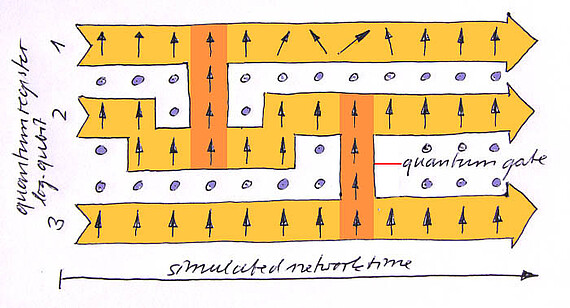Zeige Ergebnisse 21 -
40
von 89
2021
Zurel M, Okay C, Raußendorf R, Heimendahl A. Hidden variable model for quantum computation with magic states on qudits of any dimension. 2021 Okt 23. Epub 2021 Okt 23. doi: 10.48550/arXiv.2110.12318
2020
Azses D, Haenel R, Naveh Y, Raussendorf R, Sela E, Dalla Torre EG. Identification of Symmetry-Protected Topological States on Noisy Quantum Computers. Physical review letters. 2020 Sep 14;125(12):120502. doi: 10.1103/PhysRevLett.125.120502
Okay C, Raussendorf R. Homotopical approach to quantum contextuality. Quantum. 2020 Jan 5;4(217). doi: 10.22331/q-2020-01-05-217
Raussendorf R, Bermejo-Vega J, Tyhurst E, Okay C, Zurel M. Phase-space-simulation method for quantum computation with magic states on qubits. Physical Review A. 2020 Jan 31;101(1):012350. doi: 10.48550/arXiv.1905.05374, 10.1103/PhysRevA.101.012350, 10.1103/PhysRevA.105.039902
Yan X, Asavanant W, Kamakari H, Wu J, Young J, Raussendorf R. A Quantum Computer Architecture Based on Silicon Donor Qubits Coupled by Photons. in Quantum 2.0 2020. Optica Publishing Group (formerly OSA). 2020. QTu8A.15. (Optics InfoBase Conference Papers). doi: 10.1364/QUANTUM.2020.QTu8A.15
Yan X, Asavanant W, Kamakari H, Wu J, Young JF, Raussendorf R. A Quantum Computer Architecture Based on Silicon Donor Qubits Coupled by Photons. Advanced Quantum Technologies. 2020 Jun 2;3(11):2000011. doi: 10.1002/qute.202000011
Zurel M, Okay C, Raussendorf R. Hidden Variable Model for Universal Quantum Computation with Magic States on Qubits. Physical review letters. 2020 Dez 23;125(26):260404. doi: 10.48550/arXiv.2004.01992, 10.1103/PhysRevLett.125.260404
2019
Raussendorf R. Cohomological framework for contextual quantum computations. Quantum Information and Computation. 2019 Nov;19(13-14):1141-1170. doi: 10.48550/arXiv.1602.04155, 10.26421/qic19.13-14-4
Raussendorf R, Okay C, Wang DS, Stephen DT, Nautrup HP. Computationally Universal Phase of Quantum Matter. Physical review letters. 2019 Mär 4;122(9):090501. doi: 10.48550/arXiv.1803.00095, 10.1103/PhysRevLett.122.090501
Stephen DT, Nautrup HP, Bermejo-Vega J, Eisert J, Raussendorf R. Subsystem symmetries, quantum cellular automata, and computational phases of quantum matter. Quantum. 2019 Mai 20;3. doi: 10.22331/q-2019-05-20-142
2018
Bermejo-Vega J, Hangleiter D, Schwarz M, Raussendorf R, Eisert J. Architectures for Quantum Simulation Showing a Quantum Speedup. Physical Review X. 2018 Apr 9;8(2):021010. doi: 10.1103/PhysRevX.8.021010
Monroe C, Kim J, Raußendorf R. Fault-tolerant scalable modular quantum computer architecture with an enhanced control of multi-mode couplings between trapped ion qubits. US9858531B1. 2018 Jan 2. doi: https://worldwide.espacenet.com/patent/search/family/060788933/publication/US9858531B1?q=11195117
Okay C, Tyhurst E, Raussendorf R. The cohomological and the resource-theoretic perspective on quantum contextuality: Common ground through the contextual fraction. Quantum Information and Computation. 2018 Dez;18(15-16):1272-1294.
Wang DS, Affleck I, Raussendorf R. Topological Qubits from Valence Bond Solids. Physical review letters. 2018 Mai 17;120(20):200503. doi: 10.1103/PhysRevLett.120.200503, 10.48550/arXiv.1708.04756
2017
Bermejo-Vega J, Delfosse N, Browne DE, Okay C, Raussendorf R. Contextuality as a Resource for Models of Quantum Computation with Qubits. Physical review letters. 2017 Sep 21;119(12):120505. doi: 10.1103/PhysRevLett.119.120505
Delfosse N, Okay C, Bermejo-Vega J, Browne DE, Raussendorf R. Equivalence between contextuality and negativity of the Wigner function for qudits. New journal of physics. 2017 Dez 8;19(12):123024. doi: 10.1088/1367-2630/aa8fe3
Okay C, Roberts SAM, Bartlett SD, Raussendorf R. Topological Proofs of Contextuality in Qunatum Mechanics. Quantum Information and Computation. 2017;17(13-14):1135-1166. doi: 10.48550/arXiv.1611.07332, 10.26421/QIC17.13-14
Raussendorf R, Browne DE, Delfosse N, Okay C, Bermejo-Vega J. Contextuality and Wigner-function negativity in qubit quantum computation. Physical Review A. 2017 Mai 17;95(5):052334. doi: 10.1103/PhysRevA.95.052334, 10.48550/arXiv.1511.08506
Raussendorf R, Wang DS, Prakash A, Wei TC, Stephen DT. Symmetry-protected topological phases with uniform computational power in one dimension. Physical Review A. 2017 Jul 5;96(1):012302. doi: 10.1103/PhysRevA.96.012302
Stephen DT, Wang DS, Prakash A, Wei TC, Raussendorf R. Computational Power of Symmetry-Protected Topological Phases. Physical review letters. 2017 Jul 5;119(1):010504. doi: 10.1103/PhysRevLett.119.010504


